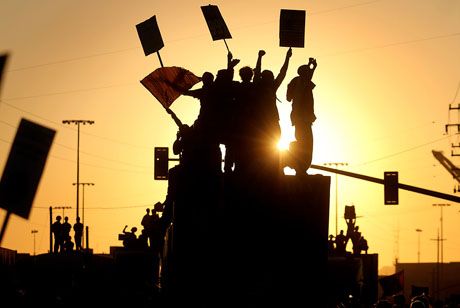Features
You are here
Quebec students strike

January 10, 2012
In 2005 nearly a quarter of a million Quebec students went on strike and defeated the government’s cuts to education. Facing new austerity measures, Quebec students are again striking, offering lessons for campus organizing across Canada.
The successful 2005 student strike in Quebec took place in the context of broader social movements.
In 2000 the Quebec women’s movement organized the World March of Women. In 2001, 70,000 people across Canada and Quebec joined mass protests in Quebec City against the Free Trade Area of the Americas. In 2003 the anti-war movement across the country reached its pinnacle in Quebec, where a quarter of a million people took to the streets—forcing the Liberal government to say no to the war in Iraq. In 2004 Quebec had its biggest May Day protest ever, with 100,000 workers marching against neoliberalism.
These movements also gave rise to a new left political party, Québec solidaire.
The 2005 strike
Quebec Liberal Premier Jean Charest campaigned in 2003 with a promise to freeze tuition fees. Once in power, Charest went back on his word in the spring of 2004, transforming $103 million of grants into loans, nearly doubling the debt of Quebec’s poorest students.
This triggered a strike, but it did not happen over night. In September 2004 student organizations began to campaign against the cuts, educating their memberships for months leading up to the strike.
On February 24, 8 local student unions (most represented by ASSE, a group calling for the complete elimination of tuition fees) began the strike.
On March 3, college students represented by the FECQ joined the unlimited strike, and on March 14 university students represented by FEUQ joined as well.
On March 15 the government tried to end the strike by offering minor concessions, but this only inflamed the student movement.
On March 16, FEUQ and FECQ called a demonstration that mobilized up to 100,000 students in Montreal, the largest student demonstration in Canadian history. The same day, almost a quarter of a million students were on strike—160,000 with FEUQ and FECQ, 50,000 with CASSE (a larger version of ASSE), and 20,000 unaffiliated.
The strike brought into the struggle unexpected contingents of students, including the whole business school of UQAM (15,000 students on strike for a week), medical schools and small regional universities, usually uninvolved in this type of movement.
The strike wave also spilled over to other members of the university, with 5,000 CEGEP teachers going on half-day strike for their won demands on March 30—while supporting the student strike.
The mass strike also won over the broader population. Thee quarters of the population supported the main student demand of transferring back $103 million from loans into grants. Some polls also showed a majority of people willing to give up a tax cut in order for that demand to be satisfied.
On April 2 the government backed down, transferring the $103 million back from loans into grants. The strike had won, and while it did not eliminate all tuition fees it showed that mass student strike can defeat government cuts and inspire broader fightbacks.
This mobilization and others is why Quebec has the lowest tuition in Canada.
New strike movement
With the economic crisis there is a renewed attack on public services around the world. In Quebec the Charest government wants to increase tuition $325 every year for five years—a 75 per cent fee increase. But
Quebec students joined the 2011 year of revolt.
In January 60,000 students from ASSE went on strike. On March 31, 2,000 students protested tuition hikes in Montreal.
Then on November 10, 200,000 students went on strike across Quebec and 30,000 marched in Montreal—the largest student mobilization since the 2005 strike.
This is part of a campaign for another general student strike in the coming months, which could stop the fee hikes and inspire students and workers across Quebec and Canada.
The February 1 Day of Action across Canada is a chance to stand with Quebec students against attacks on education.
Solidarité!
Section:
Topics:
- Log in to post comments










